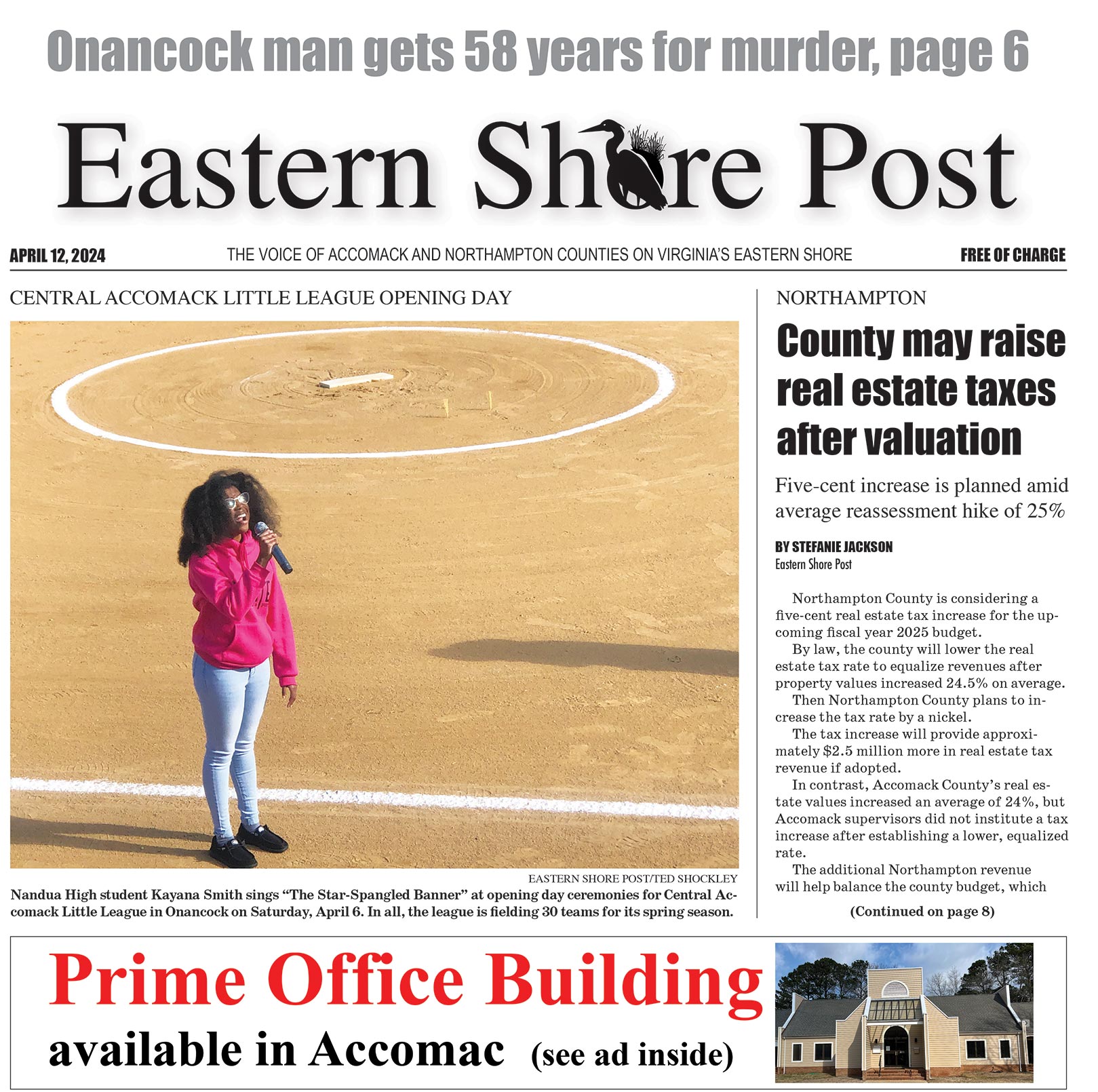By Connie Morrison
If local officials want funding in the state budget for the proposed mid-Shore force-main sewer project along U.S. Route 13, time is of the essence, Del. Rob Bloxom told a room full local officials and interested citizens last Thursday, Oct. 24.
Counties and towns should join the Hampton Roads Sanitation District via petition to the circuit court, “sooner than later, if I’m going to Richmond and sell anything,” he told the assembly, “because after Jan. 15, budget amendments are dead.”
The first phase of the proposed project is a force main from Nassawadox to Accomack to collect sewage and carry it to the Onancock wastewater treatment plant. The Onancock plant treats about 230,000 gallons per day but has capacity for 750,000 gallons of wastewater daily.
Local units of government would be responsible for costs to build the local systems that collect sewage from homes and businesses and get it to the force main, which is proposed to run generally along U.S. Route 13, much of it in the railroad right of way. Pump stations would be built in Nassawadox, Exmore, and Accomac.
The cost to construct is estimated at $24 million, with annual operating costs around $75,000. HRSD would pay the construction costs through its capital fund. Any state, and possibly federal funding, would be used to retire the debt on existing treatment plants in Onancock and Exmore. HRSD will not take on outstanding infrastructure debt.
“The overall diversification of funding is something we’re going to pursue after the petition is filed,” said Jeff Holland, who chairs the steering committee that evaluated the feasibility of a regional wastewater system. “That existing debt is why we are looking at diversifying the funding.”
Exmore owes about $500,000 and Onanocck owes about $4.5 million.
Participating localities would contract with HRSD through an operating agreement, to convey and treat the wastewater and potentially operate the collection system, too. In phase one, that would allow Exmore and Onancock to turn over existing wastewater collection systems to the district for operation and maintenance.
“Historically, all of the territories within HRSD have transferred their assets and now HRSD is fully responsible for the collection, conveyance, and treatment of sanitary sewer” in those communities, said Holland. Municipalities typically want to transfer that risk, but it is ultimately up to each municipality to decide.
HRSD would also set customer rates. The 2023 estimated charge to convey and treat wastewater is $10.15 per 1,000 gallons. HRSD’s monthly fee for maintaining the collection system is estimated at $5.78 per 1,000 gallons, for a total rate of $15.93. The maintenance rate could vary locally, so customers are advised to contact their towns or counties for local estimates.
If a town wants to connect to the system and not located along U.S. Route 13, and therefore away from the conveyance pipeline, the sanitation district would cover costs to run a connection line up to two miles off the main sewer line. Anything beyond two miles, as well as the local collection system, would be a local responsibility.
The proposed 6-inch to 12-inch diameter force main is sized to meet the projected flow to the Onancock treatment plant out to year 2050 and would replace the existing force main south of Melfa and the commercial areas of Onley, officials said.
Chincoteague was mentioned as a possible second phase and southern Northampton County as a possible third.
If the court rules favorably on the petitions, the local governments would then have access to the wastewater conveyance system, whether in the first proposed phase or some future phase. Towns that join the district are not obligated to enter an agreement with HRSD or to build sewage collection systems.
“The counties and the towns have HRSD as an option on their list of choices as relates to how they would manage wastewater,” said Holland.
The district is empowered, under law, to compel property owners to connect if “required by such reasonable rules and regulations as shall be promulgated by the Commission.”
“The commission has never had cause to utilize that clause,” Holland said.
Among the other powers granted to the HRSD commission are exercising eminent domain and issuing bonds.
The legislation does not address representation on the commission once a new territory is added. If the petition is successful, “It is perfunctory to go and then have the legislature amend the enablement,” said Holland, in a follow-up interview.
He gave the example of Surry, which was added to the district. The enabling legislation was later amended to include Surry with other southern territories for representation.
Even though a person wasn’t appointed to represent just Surry, by adding Surry to one of the representation districts specified in law, the governor would be free to choose a person from Surry as a commissioner for the district. Commissioners are expected to act in the best interest of the commonwealth, rather than the area they represent, Holland said.
He anticipates similar treatment for the Eastern Shore
Steve Mallett, chairman of the Eastern Shore Chamber of Commerce Public Policy and Advocacy Committee, read a statement from the chamber board supporting the project. “To build prosperity and economic opportunities on the Eastern Shore, our chamber supports critical infrastructure,” he read from the letter, giving the examples of broadband internet access, community health facilities, and education. “Noticeably absent is adequate sewage treatment facilities,” which the letter says will promote economic expansion and protect the environment upon which area natural resource-based industries rely.
But the first step is petitioning the court to add Eastern Shore counties and participating towns to the HRSD. Getting the petition approved by Bloxom’s Jan. 15 deadline is not likely given actions needed by local government and the hearing process. The project timeline allocates 6 months for court petitioning process.
At Thursday’s meeting, those in attendance agreed to a goal of having local decisions made by Dec. 31 to demonstrate local commitment for state budget purposes.
HRSD was created in 1940 as a political subdivision of the commonwealth, governed by an eight-member commission appointed by the governor. The body serves about 1.7 million people in the Hampton Roads area through its 16 treatment plants (nine major plants and seven smaller plants), more than 500 miles of pipes, and more than 100 pump stations. Its combined capacity is 249 million gallons per day.
The full enabling legislation can be read at https://law.lis.virginia.gov/



